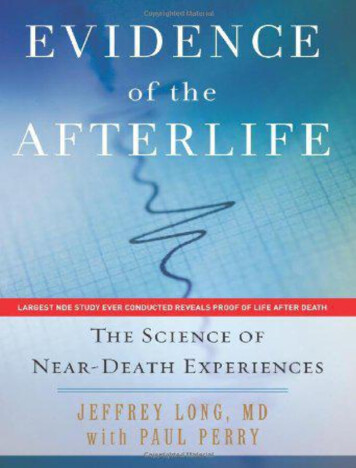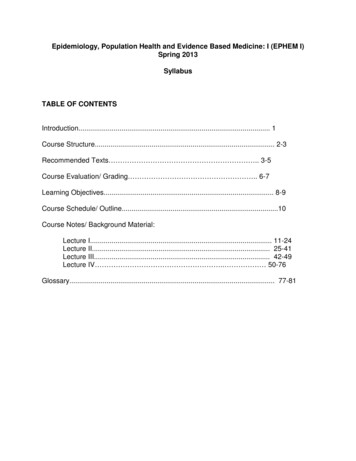
Transcription
Epidemiology, Population Health and Evidence Based Medicine: I (EPHEM I)Spring 2013SyllabusTABLE OF CONTENTSIntroduction. 1Course Structure. 2-3Recommended Texts . 3-5Course Evaluation/ Grading . 6-7Learning Objectives. 8-9Course Schedule/ Outline.10Course Notes/ Background Material:Lecture I. 11-24Lecture II. 25-41Lecture III. 42-49Lecture IV . 50-76Glossary. 77-81
I. INTRODUCTIONThis course will introduce you to the principles underlying the science ofpreventive medicine and clinical research methods, as embodied in the methodology ofepidemiology and biostatistics. The goal is to give you the skills required to be criticalreaders of the medical literature. You will draw upon these skills as you move on to theEvidence Based Medicine Sessions in Year 2 (EPHEM II), and in your clinical yearswhere you will learn more about the interpretation of the medical literature in the contextof patient care. While these skills are broadly applicable to all of clinical medicine, wewill be teaching them in the context of health promotion and preventive medicine,because the ‘population-based’ approach is directly relevant to prevention and publichealth; because prevention is, in general, less widely emphasized in the rest of thecurriculum; and because the clinical issues in prevention should be more meaningful tofirst year students, since most of you have not yet taken care of patients.You have no doubt heard elsewhere that physicians must be lifelong learners. Inorder to be lifelong learners, you must have the skills to read reports in medical journalsand understand what they mean. As a practicing physician, you will often need to turnto published articles of original research to answer clinical questions. This requires theability to critically appraise the methods and interpretation of studies. If this soundseasy, great! -- but recognize that it is a skill which many bright, hardworking, wellmotivated physicians currently lack, as noted in a recent survey of medical residents(JAMA, 298(9):1010-1022, 2007). If you become a careful, critical, comprehendingreader as a result of this course, it will have achieved its primary aim. It is expectedthat you will not determine the implications of a study simply by reading the last line ofthe abstract to see what the authors say it shows. Instead, you will critically analyze themethods and the results and form your own conclusions. This means you have todevelop the belief that you are as good a judge of the import of a study -- from your ownperspective, based on your experience, and within your own practice or community -- asthe experts who wrote the paper. Some might call this arrogance. But the only way it’sarrogant to challenge an interpretation is if it’s unequivocally correct. And so, a crucialpostulate: there are no unequivocally correct interpretations of clinical studies. This isnot to say there is no truth -- simply that our attempts to uncover the truth are limited,and open to interpretation, and that what is correct in Minnesota may not be correct inthe Bronx.So as we develop our skills at critical assessment of the literature, you may findthat you disagree with an interpretation or opinion of a speaker in this class. If you do,you should raise your hand and ask a question, or make your point. You areencouraged to [respectfully] challenge any statement made by your teachers or peers.Keep in mind that this course, even though it is given in a year dominated by basicscience lectures, is different. While there are a series of facts you must know tosucceed in this course, the learning of facts is not our primary goal. Rather, our goal isto help you to develop your critical reasoning skills, and thus, active participation in thediscussions is necessary for achieving this goal.1
II. COURSE STRUCTUREPlease take the time to familiarize yourself with the overall description of the coursestructure that follows.PART I. BASIC PRINCIPLES: LECTURES Sessions 1-4 (March 5, 12, 19, April 16)PART II. CASE DISCUSSION GROUPS (several sections-see group assignmentson the course webpage): Sessions 5-10 (April 23, May 7, 9, 14, 21, 28).REVIEW SESSION: May 29th at 9 am, Riklis AuditoriumFINAL EXAM: (short answers/essays, in class): Monday June 3, 9:30-12:00pm, Robbins Auditorium.PART I:The lectures are designed to provide an intensive ‘mini-course’ on epidemiology andbiostatistics. Lectures will cover the “Learning Objectives” which follow in this syllabus,and are designed to provide you with the basic tools required to evaluate the relatedcase studies and to be an active participant in the case-discussion groups. Lectures areall given in Riklis Auditorium at the times noted on the schedule. The backgroundmaterial for these lectures is included in this syllabus. The lectures will provide someinteractive problems/ and examples to build upon the material in the syllabus. Forfurther reading, see the section below on recommended texts.A self-study problem set will be posted on emed for each lecture. These willprovide you with a review of the key points and practice answering questionsbased on the learning objectives.PART II. CASE DISCUSSION GROUPS:There will be a total of six case discussion sessions. These are the heart of the course,and provide you with the opportunity to apply the basic principles to the interpretation ofactual research studies in the context of clinical scenarios. Active participation anddiscussion is the key to the success of these sessions. A portion of the time for eachsession will involve working in groups of 4-5 students to complete a hands-on problemset related to the day’s case. The remainder of the session will be a discussion of theproblems and the focus readings in the context of the teaching objectives and assigneddiscussion questions. Group assignments for the case conferences are posted on thecourse webpage. Each session will be based on 1-2 focus journal articles related to anaspect of clinical research. The materials for each session will be available on theemed course page.The expectations for each session will be clearly laid out in the weeklyassignment on the course webpage. Each assignment will include:2
Learning objectives for the session Required focus article(s) for the case discussion. Relevant sections of the course syllabus and recommended text forbackground reading A brief quiz regarding the readings and background material . The quiz foreach sessionwill be available on emed and must be completed by 12pm thenight prior to the scheduled session. These 6 quizzes plus the quiz afterthe last lecture will comprise 20% of your course grade. Responses will beused by your section leader to facilitate the discussion. These questionsets will comprise 20% of your final grade. The quizzes are designed to provide feedback once the answers have beensubmitted, ADVANCE PREPARATION FOR, AND PARTICIPATION IN, THIS PORTIONOF THE COURSE IS ABSOLUTELY MANDATORY. This cannot be overstated:we cannot successfully employ this teaching method if you are unprepared. Wewill abide by the following ground rules:1. ATTENDANCE IS MANDATORY. As with all small group sessions at Einstein,attendance at the sessions is mandatory. Unexcused absence is grounds forfailing the course, and will be reported to the office of student affairs. Absencesmust be excused by the course leader prior to the session, or in the case of anemergency, by the next day. A required make-up assignment will be provided forany excused session.2. PREPARATION IS MANDATORY. Faculty will expect you to be prepared, andwill elicit your contributions to discussions when you volunteer, but alsosometimes when you do not.3. COMPLETION OF THEQUIZZES PRIOR TO EACH SMALL GROUP SESSIONIS MANDATORY. You will be able to use the quizzes as a self-study tool, andresponses will be used by the small group leaders to facilitate the discussion,and to identify areas of confusion. Completion of these study questions willcount toward 20% of your grade as noted above.III. RECOMMENDED TEXTS.This syllabus includes brief discussions of the major topics of the course. These areorganized in relation to the topics of the 4 lectures. However, the syllabus covers thismaterial in a cursory and concise manner, and in order to supplement the syllabus, Ihighly recommend the following text for the course (this is available in the Einsteinbookstore):Gordis L. Epidemiology, (fourth edition). Elsevier Saunders, 2009.3
This is a clearly written text that covers basic principles of epidemiologic research.Although some sections provide more detail than this course requires, feedback fromstudents in later years has indicated that it is considered an excellent reference to beused throughout your medical education. Review questions in each chapter provide theopportunity to apply the principles to the interpretation of real research scenarios.In the course schedule, I have noted the sections of this book that are relevant to thematerial in the lectures. In addition, the online materials for each small group sessionwill include sections of the Gordis book that will give more in depth discussions of thelearning objectives.If you desire more detailed readings on biostatistics, I recommend the following,which will be on reserve in the library:Wassertheil-Smoller S. Biostatistics and Epidemiology: a Primer for Health andrdBiomedical Professionals (3 Edition). Springer-Verlag, 2004.A concise, practical text, written by an important member of our faculty.Particularly strong are its sections on biostatistics and clinical trials, and a sectionon genetic epidemiology (new to the 3rd edition). Many students have reportedthat they have used this book, and found it very helpful.Colton T. Statistics in Medicine. Little, Brown: 1974.This is a classic primer of biostatistics.In addition, for those of you who want to go into more depth, I recommend the followingtexts, which will be on reserve in the library:Gehlbach SH. Interpreting the Medical Literature (4th Edition). McGraw Hill; 2002.A highly readable text, geared toward teaching how to use knowledge ofepidemiology and biostatistics in the critical evaluation of the medical literature.It will remain a useful reference during the clinical years, but lacks a publichealth/prevention focus, so is not entirely suitable for this course.Glantz, SA. Primer of Biostatistics (5th Edition). McGraw-Hill; 2001.Statistical discussions beyond the level of this course, but it could be a usefulreference for those whose curiosity is piqued to delve a bit into statistical theory.Hebel, J., McCarter RJ. A study guide to Epidemiology and Biostatistics, 7th edition.Jones and Bartlett: 2012.Aschengrau A., Seage GR. Essentials of Epidemiology in public health. Jones andBartlett: 2003.Greenberg RS. Medical Epidemiology.McGraw Hill 2005.4
Greenberg RS, Daniels SR, Flanders WD, Eley JW, Boring JR. Medical Epidemiologyth(4 Edition). McGraw Hill/ Lange Medical Books; 2005.This book provides a good overall review of Epidemiologic methods, andprovides practice questions in each chapter.Jekel JF, Elmore JG, Katz DL. Epidemiology, biostatistics, and preventive medicine (2ndEdition). Saunders; 2001. COMPANION REVIEW BOOK: Katz DL. Epidemiology,biostatistics, and preventive medicine review. Saunders; 1997.A book that is particularly well suited for this course. Students may particularlylike the organization of the review book, with questions and answers.Kahn HA, Sempos CT. Statistical Methods in Epidemiology. Oxford University Press,1989.This provides a nice background to basic statistical methods used inepidemiology, in greater detail than the other suggested texts.Sackett DL, Haynes RB, Guyatt GH, Tugwell P. Clinical epidemiology: a basic sciencefor clinical medicine (2nd edition). Little, Brown: 1991.Sackett DL, Haynes RB, Straus SE, Richardson WS, Rosenberg W. Evidence BasedMedicine. Harcourt Health Sciences: 2000.Szklo M, Nieto FJ. Epidemiology: Beyond the Basics. Jones and Bartlett, 2004.This is a more advanced text for those of you who really want to delve further.While this is beyond the scope of our course, it might be a good reference in thefuture.IV. ON-LINE MATERIALS. The syllabus is up on our Web site, and includes some linksto other useful sites. (Note: if you have any web links to suggest, please let me know.)A particularly useful web resource for statistics information is an on-line statistics‘textbook’ called Hyperstat: http://davidmlane.com/hyperstat/index.htmlAnother resource, for those who’d like to complement our lectures/readings with an online series of lectures on epidemiology and public health, is the “Supercourse” inEpidemiology:http://www.pitt.edu/ super1/ which compiles lectures from faculty and professionalsfrom around the world.Finally, there was a series of articles in the British Medical Journal regarding “How toRead a Paper” (BMJ 1997;315). These are all listed on the following website, whichincludes links to other relevant articles. The series provides a nice guide to applying theliterature to clinical practice, and might prove useful in the future as you begin toevaluate the literature in EPHEM II and in clinical /science/medlit.shtml5
6
V. COURSE EVALUATIONS/ GRADINGThis is a pass fail course. Passing the course will require the following: Attendance at ALL small group sessions. Completion of all 6 on-line quizzes BEFORE MIDNIGHT the day of each casediscussion session Passing the Final Exam with a score of 65% or higher. (June 3rd, RobbinsAuditorium 9:30-12:00), (see details below). An overall course grade of 65% or higher. Final Grade is based on: 20%: Quizzes as noted above. 80% final exam.The real issue is: “how can I learn what’s important?” That should be straightforward, ifyou follow the steps below, you should be well prepared for the final: Be prepared for class by doing the assigned (required) readingCome to class (and come on time)Participate in class discussionsFollow up on any material you didn’t understand by reviewing thesuggested readings for that session, or contacting (preferably by email)your group leader or the course leader if you’re still confused.SMALL GROUP SESSION QUIZZES (20% of final grade):As noted above, the assignments for each small group session include completing aquiz available on the EPHEM I emed page. Quizzes will be posted prior to eachsession and must be completed by MIDNIGHT the day of the session. The purpose ofthe quizzes is to assess your preparedness for the small group sessions. Questions willbe based on the assigned articles, and on the material from the syllabus/lectures that isrelevant to the learning objectives for the case In addition, each quiz will be set up toprovide feedback for you to use in preparing, and to help you clarify concepts prior tothe discussion. Finally, the section leaders will use the information regardingdistribution of answers to identify areas that might require extra time in the discussion.FINAL EXAM (80% of final grade/ MUST PASS THE FINAL with 65% to PASS theCOURSE)The final exam will be a short answer/short essay exam (i.e. not multiple choice), andwill be administered in class. It will be based on interpretation of a recent/current7
journal article (one that probably hasn’t been published yet as this syllabus goes topress). The article for the final exam will be posted on emed for you to review andstudy one week prior to the final exam, on Monday, May 27th. The date of the finalexam is June 3, 9:30-12:00, Robbins auditorium. (Date for exam review session:May 29, 9:00-10:15 AM, Riklis Auditorium.)VI. SUPPORT/ FEEDBACK/ QUESTIONSYour section leaders will be available after each class, through email, and byappointment. If you ask an important question by email, your question and an answermay be sent to the entire class – but your name will be deleted from thecorrespondence. Contact for your section leader is listed on the course website alongwith the group assignments.Also, through the duration of the course, Dr. Derby will be available to allstudents. Simple questions are best addressed by email; if you wish to schedule anappointment, please call Dr. Derby at 430-3882. If you have administrative questionsregarding the course, please call Ms. Margie Salamone at 430-3465. ALLQUESTIONS REGARDING EXCUSED ABSENCES MUST BE be directed to yoursection leader, with Dr. Derby copied on the email.8
LEARNING OBJECTIVESThe overall goal is to acquire the tools required to critically evaluate the medicalliterature and to understand how studies conducted in populations relate toclinical practice and care of the individual patient.At the end of this course, you should be able to define and interpret each of thefollowing concepts: (bold print major objectives):TYPES OF STUDY DESIGNS and the pros and cons of nical trialsMEASURES OF DISEASE/ RATESprevalence and incidence and the difference between themMEASURES OF ASSOCIATION (RISK ESTIMATES)absolute risk (incidence)relative riskodds ratioattributable risknumber needed to treat (NNT)/ Number needed to harmTYPES OF BIASselectiondetectionrecallconfoundingSCIENTIFIC REASONINGthe null hypothesis/ hypothesis testingcausal inferenceSTATISTICAL INFERENCE/VARIABILITY AND ESTIMATIONsampling distributionsstandard deviation, standard errorthe null hypothesisp-valuesconfidence intervals9
chi-square, Fisher’s testst-tests, ANOVA, Wilcoxonpower and type II errorsignificance and type I error1- vs. 2-tailed testsWays to control for confoundingmultivariate analysislogistic regressionstratificationlife tables/Cox modelsCLINICAL -to-treatSCREENING AND CLINICAL DECISION MAKINGpros and cons of screening testslead-time and length biassensitivityspecificitypositive and negative predictive values10
Course ScheduleLecture / Case ConferenceRelevantChapters inGordisLECTURE I: Introduction: What kind of study is this, andwhy does it matter?Chp.1Chp 7:131-137138-140Chp 9Chp 10:177-180March 12: 1:45-3:45LECTURE II: How strong are these results and should Ibelieve them?Chp 3:37-40,43-47, 50-52Chp 10:180-191Chp 11:215-216220-221March 29: 1:45-2:45LECTURE III: From screening to diagnosis.Chp 5:85-91,96-101April 16: 1:30-3:30LECTURE IV: Are these results “Significant”?: Samplingand Principles of statistical inference.DateMarch 5: 1:30-3:30April 23: 1:30-3:30CASE CONFERENCE 1: Prospective population basedstudies: The Framingham StudyMay 7: 1:45-3:45CASE CONFERENCE 2: Case-Control Studies. Doll andHill on Lung CancerMay 9: 1:45-3:45CASE CONFERENCE3: What puts the P in P-values?Practice with basic inferential statistics.May 14: 1:45-3:450CASE CONFERENCE 4: Randomized Clinical Trials: TheLipid Research Clinics StudyMay 21: 1:30-3:30CASE CONFERENCE 5: PSA Screening for ProstateCancerMay 28: 1:30-3:30CASE CONFERENCE 6: Critiquing and Article.May 29: 9:00-10:15Review Session : Riklis AuditoriumJune 3 :9:30 am -12pmFINAL EXAM: ROBBINS AUDITORIUM11
EPHEM ILecture I: Introduction to the Epidemiologic ApproachThis lecture will provide and introduction to epidemiology and its applications toclinical practice, will discuss basic concepts of study design, and an introductionto basic measures of disease occurrence.Learning Objectives:At the end of this lecture, you should be able to:1. Discuss the difference between observational and experimental studies.2. Define ecological and cross-sectional studies.3. Describe the design of cohort (prospective) studies, and of case-control(retrospective studies, and discuss the advantages and disadvantages of each.4. Define the advantages of randomized controlled trials.12
BACKGROUND LECTURE I: PRINCIPLES OF STUDY DESIGN AND ANALYSISI. Introduction: What is Epidemiology/ Why do we need to know?Epidemiology is the study of the distribution and determinants of disease inpopulations. The roots are Greek: “epi” meaning upon; and “demos” meaning thepeople. So what we’re concerned about is that which is upon the people (such asplague, pestilence, and the like). The goals of epidemiologic studies are to identify theextent and causes of disease, study the natural history and prognosis of disease, testpreventive strategies and treatments and provide data for making public health policydecisions.How does epidemiology relate to clinical practice? First, the ability to make adiagnosis depends upon knowledge obtained from studies relating clinical findings topathology/ disease in large groups of patients. Second, the ability to give a prognosis isbased upon population data regarding the clinical course of large groups of personswith a specific disease. Finally, choices regarding treatments are based on results ofclinical trials that evaluate therapies in large groups of patients. Thus, while clinicaldecisions relate to individuals, the knowledge/ data that form these decisions arepopulation based.II. Overview of Study Designs used in Clinical Research:To be able to critically interpret studies in the literature (or to design your own), youmust have an understanding of the issues involved in study design, to learn the impactof design on what we observe and what inferences we can make.In general, the goal of any epidemiologic study is to establish whether there is anassociation between an exposure (or characteristic) and an outcome.Epidemiologic studies may be classified into two groups:Experimental studies are those in which the investigator manipulates or controls theexposure of interest and examines the association of the exposure to a particularoutcome. Randomized Controlled Trials are considered the “gold standard” in terms ofproving causation or evaluating a treatment.However, there are situations in which it is not ethical to randomize subjects toexposure. For example, if one suspects that a toxic pesticide is a carcinogen, it wouldnot be ethical to randomize study participants to exposed and unexposed groups.Instead, you must design a study in which you observe the disease rates in those withand without the exposure of interest, or an observational study. There are many typesof observational studies, and we will study these and clinical trials in depth in theremainder of the course, using the case conferences to explore their design andinterpretation.13
A. Observational Studies1. Case Series: Clinical observations in series of patients or case-series often provideclues to possible etiologic factors. For example, one of the first suggestions thatsmoking might be related to lung cancer came from the observations of a surgeon whoobserved that the vast majority of his lung cancer patients reported that they smokedcigarettes. However, case-series are limited in that they do not include a control orcomparison group. Without comparing the rates of smoking in lung cancer patients tothose without lung cancer, there is no way to determine whether smoking might berelated to the disease.2. Ecological Studies: An ecological study: is based on comparisons of group data,and can provide clues regarding exposure/ disease associations. However, ecologicalstudies are distinguished from other observational studies by the fact that they do nothave data on individuals, and thus the inferences to be drawn from the study arelimited. For example, if you were comparing mortality in Alaska and Florida, you wouldbe conducting an ecological study. Based on the observation that mortality rates arelower in Alaska, we might make the inference that exposure to cold air increaseslongevity. We might make this inference -- but I expect we wouldn’t. There are twoimportant reasons to avoid this inference:a. Cold air exposure is not the only difference between these populations.Even after adjusting for age and sex, there are important differencesbetween the populations other than the climate. For example, many peoplemove to Florida when they retire, and many people move to Alaska to findemployment. This does, to be sure, contributes to the difference in agedistribution -- but even after taking that into account, the fact remains thatpeople who are working, at a given age, are healthier than those who don’t(the so-called ‘healthy worker effect’), and that healthier people have a lowermortality rate;b. Since we’re looking at summary statistics for an entire population, we’re notable to specifically associate any particular risk factor with the people whoactually have the outcome. Sure, it’s warmer in Florida -- but that doesn’tmean that the particular people who died were exposed to excessivewarmth. To take it to an absurd extreme, what if all those who died inFlorida worked in a refrigerated meat packing plant, and all those who diedin Alaska worked in a hot iron-smelting factory? That is, in ecologicalcomparisons, even if a putative risk factor seems to be associated with anoverall rate, we can’t determine whether anyone with the outcome wasactually exposed to the specific risk factor. This is called the ‘ecologicalfallacy.’3. Cross-Sectional Studies: A cross-sectional study is one in which the presence of asuspected exposure and the presence of the outcome (or disease) are ascertained14
simultaneously. In other words, we take a “snap-shot” or survey of the study populationat a particular time. These studies can be valuable in establishing associationsbetween suspected factors and disease, but are limited in that we do not know whichcame first. In other words, we do not know the temporal sequence of the exposure andthe outcome. The problem is that we sometimes want to make inferences from crosssectional studies that are not appropriately made by observations at a single point intime.For instance, we might be interested in finding out whether doctors read fewer medicaljournals as they get older. We do across-sectional study of practicingJournal reading habits ofphysicians, and ask them howphysiciansmany journals they read eachmonth. The results are summarize6din the chart to the right.5It’s certainly tempting here to4conclude that as physicians age,3Journals/mo.they read fewer journals. But think2about it: we’re not looking at any1physician as s/he ages, but rather0at different age groups of30-3940-4950-5960-69physicians at a single time. Sure,they MAY change their habits overtime: but it’s just as plausible thatphysicians in their sixties ALWAYS read fewer journals (in fact, many fewer journalswere published when they started in practice, and perhaps physician habits re: readingwere different). So what we may be seeing is not a change over time in individuals, buta change in each individual cohort: those who became physicians in the 1960s, 70s,80, or 90s. This is what’s known as the cohort effect, and underscores the danger inmaking longitudinal inferences from cross-sectional data.In summary each of the study designs above suffers from design limitations that limitthe inferences that can be made from the results. Case series lack a control orcomparison group, ecological studies lack data on individuals, AND neither ecologicalnor cross-sectional studies provide information regarding the temporal relationshipbetween exposure and disease.The two the remaining types of observational study designs improve upon thesedesigns cohort studies and case-control studies.4. Cohort/ Prospective Studies: One way to determine whether an exposureincreases the risk of developing a disease is to select a group of people who have theexposure and a group that does not, and to follow these groups to see the rates atwhich each develops disease. This study design is called a cohort study. If, forinstance, we believe that hypertension may lead to subsequent heart attacks and15
strokes, we can study people with hypertension with those without hypertension, andcompare the incidence rates of these outcomes. If we enroll those patients today, andlook for MIs and strokes 10 years from now, that would be a cohort study. (TheFramingham Heart Study is the classic example of such a study.) Cohort studies areoften called prospective studies, because we are prospectively following exposed andunexposed groups through time to determine occurrence of the outcome.Design of Cohort (Prospective) StudiesBegin utDiseaseNoDiseaseorDiseaseNotExposedNoDisease4a. Identification of subjects: Choosing a cohort and determining exposure statusWhen we decide to perform a cohort study, we first try to identify a group withsome similarities (for instance, born between 1930 and 1939), and without the diseaseof interest at entry into the study (we are interested in incidence or development of newdisease). Such a group is called an inception cohort. There are several approaches.One may begin by selecting a cohort who lives in a particular area (say residents ofFramingham MA). Another approach is to select persons in particular groups, such asphysician, nurses, veterans, or medical plan subscribers.Once a group is selected, the investigator must determine who in that group was'exposed'. This term is itself an oversimplification, since exposure is usually not an allor none is
preventive medicine and clinical research methods, as embodied in the methodology of epidemiology and biostatistics. The goal is to give you the skills required to be critical readers of the medical literature. You will draw upon these skills as you move on to the Evidence Based Medicine
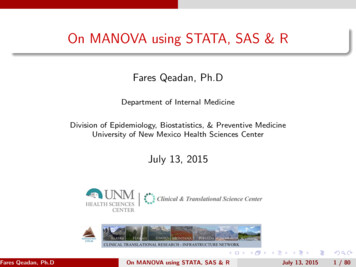
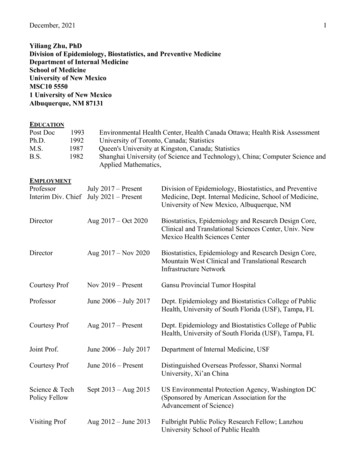
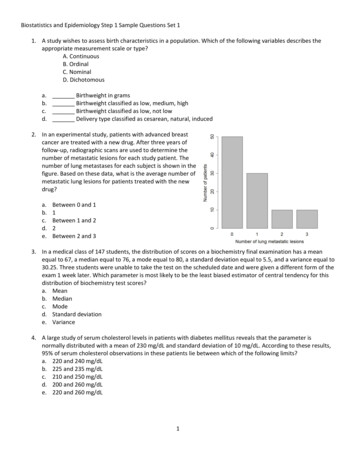
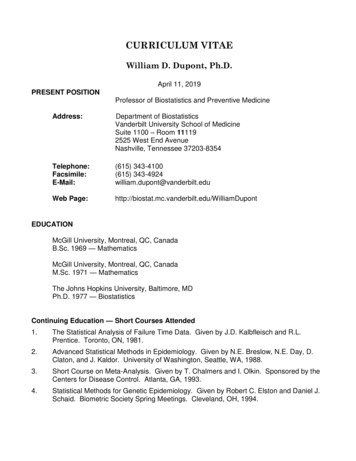

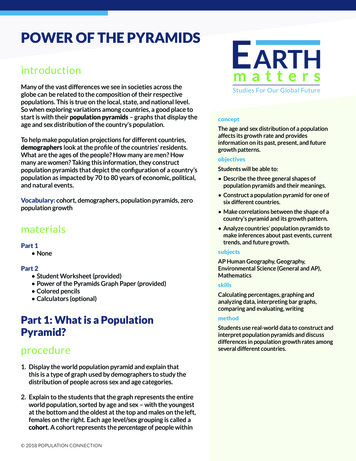

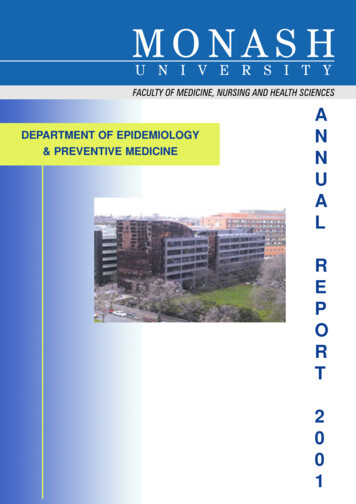
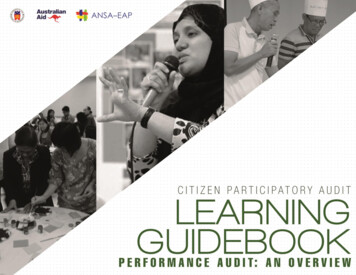
![project2 Encase.pptx [Read-Only]](/img/12/project2-encase.jpg)
